Welcome to Hank’s March-April 2024 Astrophotography Blog! The skies these last two months were again a challenge, and we were in Texas for the eclipse, so I have not spent too much time at my telescope. But I have a few things to show you, and of course the Total Eclipse of April 8th!
To start off with, I was able to capture two images from my backyard observatory. NGC 4565, is an edge on galaxy in Coma Berenices constellation. If we could turn it on its side, it would most likely look like our own Milky Way spiral galaxy. Can you spot the smaller fuzzy galaxy in the corner, NGC 4562? Then, the Moon. It was a very clear night on April 13th, and I was able to get some good surface detail here.
I also took a photo of M 101, the Pinwheel Galaxy. I’ve taken photos of this one many times, but I wanted to get ready for a project that our Black Hills Astronomical Society is doing. We are planning for several members (right now there are about 8-9 of us) to capture as many hours as we can of this galaxy, with a goal of 8 hours each. With a goal of 70+ total hours of capture time, we will process all data from multiple telescopes and cameras into one Master image of M 101. What we are looking for is to see how much more detail we can acquire by really bumping up the data we capture. It’s a pretty cool experiment. Perhaps the over-arching goal with the M101 project is to broaden and improve skills of amateur astrophotographers in the BHAS. We hope to have a group image of M101 completed by the end of July, if not sooner.
We were inspired to conduct the M101 group imaging project by a project currently being conducted by another group of amateur astronomers in the United States, Europe, and Chile to capture two “Amateur Deep Field” images, one in the Northern Hemisphere and one in the Southern Hemisphere, similar to the “Hubble Deep Field” image. The Hubble Deep Field image was obtained by scientists using the Hubble Space Telescope over a period of 10-days in 1995. The Hubble Deep Field Image somewhat revolutionized our understanding of our universe and the galaxies, stars and matter within it. Not sure how much else I will be able to capture for my May blog, but stay tuned, as we hope to start doing the processing of the data in June….
The eclipse. We had a great trip down to Austin, Texas. We took the pickup and camper and had a great time. Highlights were the bats of Austin, a host of LBJ historical sites, the Bullock State Museum, and the Lady Bird Johnson Wildflower Center. We camped right in Austin at the McKinney Falls State Park. Joining us there were our friends Jeff and Ronni from California. A great visit and fun to share the sites with them.
The night before the eclipse the weather forecast predicted clouds in much of Texas. So I ran into a site that showed where they were predicting the clouds to be in Texas, and penciled those cloudy spots on a map with the eclipse path. I then traced the possible highways north of Austin until I found an area that was out of the clouds, in the eclipse zone, and near a town. Turns out that Goldthwaite, Texas filled the bill. It wasn’t dead center on the eclipse center, but it would give us about 2 minutes of darkness. So about 5:00 on the morning of the 8th, we bid adieu to Jeff and Ronni and were on the road to the eclipse, hoping that the weather predictions were correct. Goldthwaite had one of those RV parks that is really more of a place to live in your camper. Most all the campers there worked nearby. We pulled in and asked if they had any spaces open and were told they had an “Eclipse Special” for us for $100 a night. Electrical, but no water, and one shower that was working but under construction. Hmmmm. We told them we’d think about it and call back later if we changed our minds, leaving our phone number. 15 minutes later they called us back and the price dropped to $50, so we took them up on it. We got the camper pulled in and set up our chairs for the eclipse. Initially I was thinking I’d just enjoy the eclipse and not take any photos, but the temptation was just too great. So, I set up my little telescope, clamped my iPhone on the telescope holder and took a couple of practice shots. I blocked most of the light coming into the front of the telescope and duct taped one of the filters from an extra set of solar glasses I had to the front. I wasn’t sure how to set the exposure for all the different light variations we’d be having during the eclipse, so I just let the phone deal with the exposure levels.
What you see below is the lead up to the eclipse, with the Moon slowly covering the Sun from what’s called the “first contact” to a thin crescent. During this time I was alternately wearing my solar glasses, and peeking at my iPhone/snapping photos. Then just before the darkness of Totality, Bailey’s Beads showed up in the phone screen! These show the last faint glow of the Sun shining through the bumpy geography of the Moon. Then Totality, where the Moon totally covers the photosphere of the Sun (the actual surface of the Sun), but shows the Corona surrounding the Sun (the atmosphere of the Sun, which for some reason is believed to be hotter than surface of the Sun!). This Totality photo is a combination of 4 photos that I took, because I wanted to show as much of the Corona as possible. Two minutes! That’s all Totality lasted. It was amazing. I could take off my solar glasses for Totality safely, and it was just breath-taking. It was dark enough for us to see Jupiter and Venus near the Sun! The Sun itself just seemed to be a deep black, but it was surrounded by the fiery ring of the Corona. I can’t explain the feeling we got witnessing it. Meanwhile, all around us it was dark out, the birds stopped chirping, it got cool, the humidity seemed to drop, the wind stopped. Then in a flash, a bright pinpoint of light popped out from behind the moon, that was still circled by the Corona, and out came—The Diamond Ring! I think I screamed as I quickly put my solar glasses on. Then as quickly as it showed up, the Moon began to roll away, revealing more and more of the Sun. Within a few minutes, though, clouds began to appear in the sky between the Sun and us, and I stopped taking photos. What an experience!
As I mentioned in February, I’ve started subscribing to a service called Telescope Live, that allows me to download raw image files they have taken using their powerful telescopes in Chile, Australia and Spain. Here are some remarkable images that I have downloaded from their site and used Siril, Afinity, Photoshop Elements and Topaz DeNoise to process. Some of these telescope cameras capture light in the visible light spectrum, like my own Mallincam DS10c at home does, the Reds, Greens and Blues. But some of the Telescope Live telescopes also capture light from parts of the spectrum that we cannot see, such as light from Hydrogen, Sulfer and Oxygen (Ha, SII, OIII). What happens is that the cameras can convert those wavelengths into Reds, Greens and Blues so we can see them. This is not how they would appear in space to us, because our eyes cannot see those wavelengths, but are converted into something we can see, so we can get an idea of their shape and the variety of invisible light there is out there. A good example of an object that we could not see looking through a regular visual telescope is the Spaghetti Nebula, shown below.
Finally, one last Telescope Live image that I processed using Afinity software– our own Sun. This was captured using the Ha filters on a special solar telescope/camera that was in Arizona. Notice the details around the edge and the texture of the Sun’s photosphere. Way cool, huh?
I’d like to give a shout out to BHAS members Chris and Rod, for their help in getting us organized for the group capture of M 101. The Black Hills Astronomical Society has a number of members with great experience and expertise, that has been such a support to us newbies. Thanks, gang! You make a huge difference!
Until next month, Clear Skies. -Hank




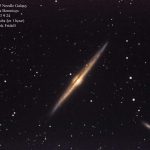
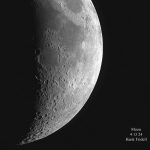
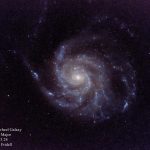
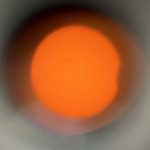
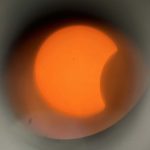
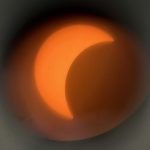
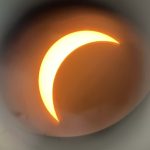
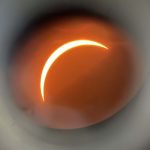
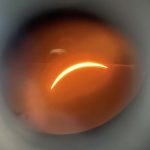
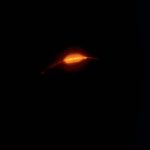
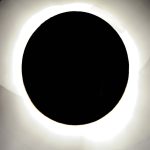
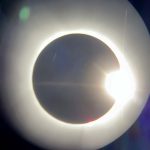
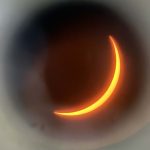
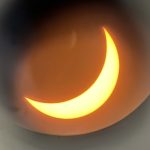
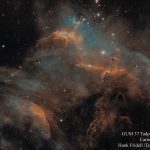
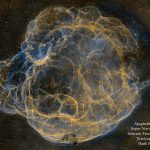
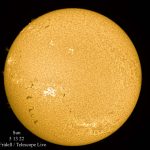
Great blog! How interesting the eclipse trip. Sure like the group project. How about the technology
I can definitely relate to the “temptation was too great” part when it comes to just enjoying the moment or taking pictures.
Thanks Mike! I’ve got a couple of nights in now trying to get images for the group project. We really have to grab the images when the sky is right, so every night we are clear I’ll be out this month. I could post all those M101 captures in the blog! So far I have a few over 90 of them…. Take care! -Hank
Mike Webster–If there’s a button, I gotta push it. The technology just sucks me in… -Hank